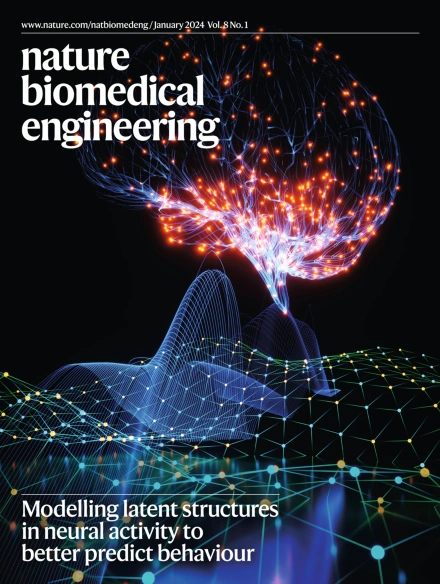利用PepMimic结合界面模拟进行肽设计。
IF 26.8
1区 医学
Q1 ENGINEERING, BIOMEDICAL
引用次数: 0
摘要
多肽为靶向治疗提供了优势,包括口服生物利用度、细胞渗透性和高特异性,使其与传统的小分子和生物制剂区别开来。在这里,我们开发了一种人工智能算法PepMimic,通过模拟靶标与已知结合物之间的结合界面,将已知受体或靶标的现有抗体转化为短肽结合物。我们将PepMimic应用于药物靶点PD-L1、CD38、BCMA、HER2和CD4。表面等离子体共振成像结果显示,8%的肽的解离常数(KD)值在10-8 M水平,26个肽的KD值低至10-9 M,大大高于在相同条件下进行的随机文库筛选。我们将PepMimic应用于缺乏有效结合物的靶蛋白,首先利用现有算法设计蛋白质结合物,然后通过模拟这些人工界面设计肽。我们在乳腺、骨髓瘤和肺癌小鼠模型中使用尾静脉注射广泛验证了排名靠前的肽。实验结果证明了膜结合的有效性,并突出了其在临床诊断成像和靶向治疗应用方面的强大潜力。本文章由计算机程序翻译,如有差异,请以英文原文为准。
Peptide design through binding interface mimicry with PepMimic.
Peptides offer advantages for targeted therapy, including oral bioavailability, cellular permeability and high specificity, setting them apart from conventional small molecules and biologics. Here we develop an artificial intelligence algorithm, PepMimic, to transform a known receptor or an existing antibody of a target into a short peptide binder by mimicking the binding interfaces between targets and known binders. We apply PepMimic to drug targets PD-L1, CD38, BCMA, HER2 and CD4. Surface plasmon resonance imaging results show that 8% of the peptides exhibit dissociation constant (KD) values at the 10-8 M level, and 26 peptides achieving KD values as low as 10-9 M, substantially higher than random library screening conducted under identical conditions. We apply PepMimic to target proteins lacking available binders by first using existing algorithms to design protein binders, followed by designing peptide through simulating these artificial interfaces. We extensively validate the top-ranked peptides using tail vein injections in breast, myeloma and lung tumour mouse models. Experimental results demonstrate effective membrane binding and highlight their strong potential for clinical diagnostic imaging and targeted therapeutic applications.
求助全文
通过发布文献求助,成功后即可免费获取论文全文。
去求助
来源期刊

Nature Biomedical Engineering
Medicine-Medicine (miscellaneous)
CiteScore
45.30
自引率
1.10%
发文量
138
期刊介绍:
Nature Biomedical Engineering is an online-only monthly journal that was launched in January 2017. It aims to publish original research, reviews, and commentary focusing on applied biomedicine and health technology. The journal targets a diverse audience, including life scientists who are involved in developing experimental or computational systems and methods to enhance our understanding of human physiology. It also covers biomedical researchers and engineers who are engaged in designing or optimizing therapies, assays, devices, or procedures for diagnosing or treating diseases. Additionally, clinicians, who make use of research outputs to evaluate patient health or administer therapy in various clinical settings and healthcare contexts, are also part of the target audience.
 求助内容:
求助内容: 应助结果提醒方式:
应助结果提醒方式:


